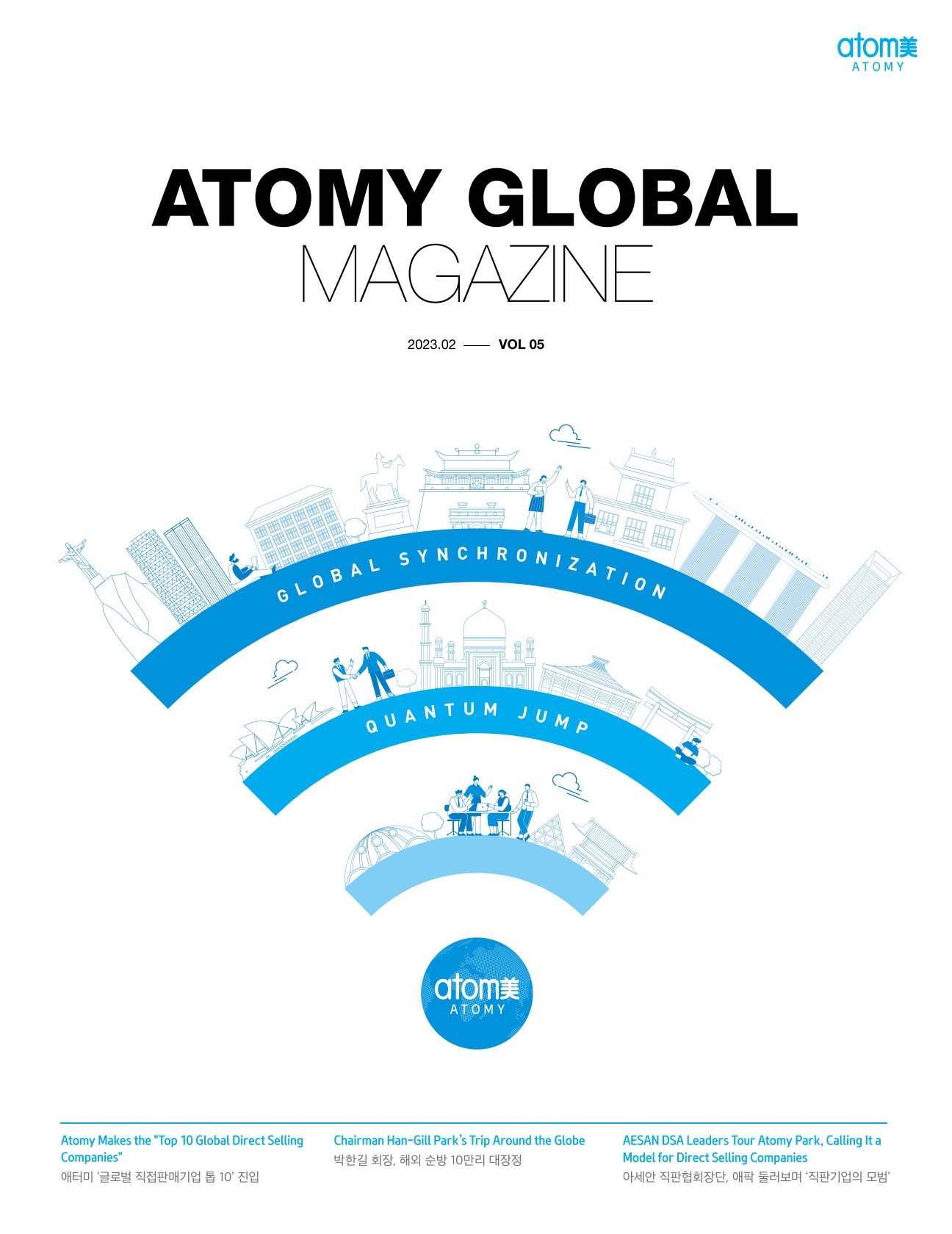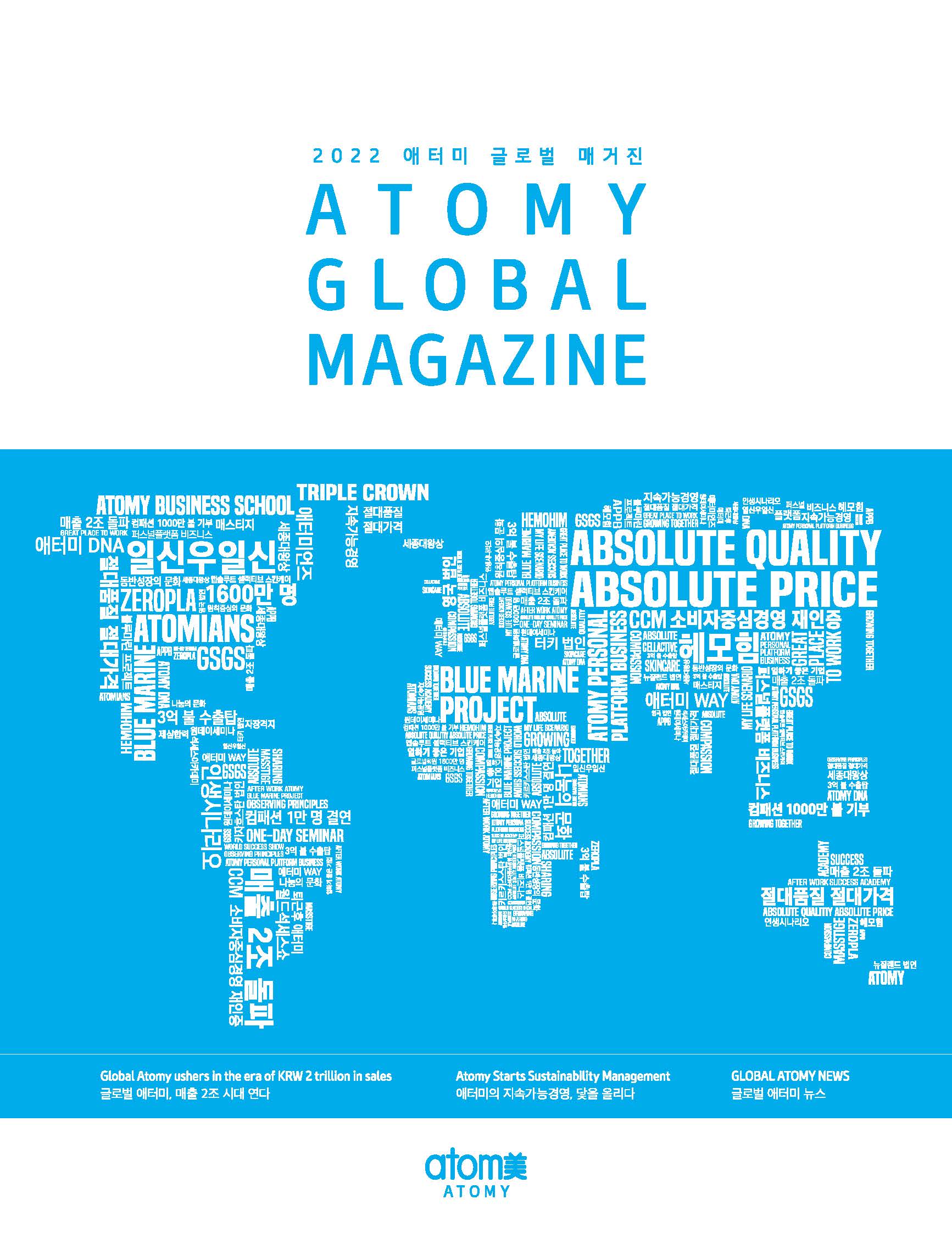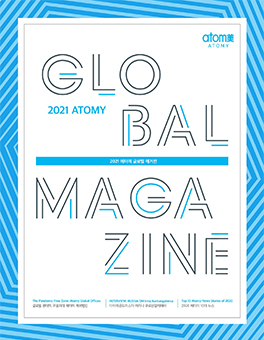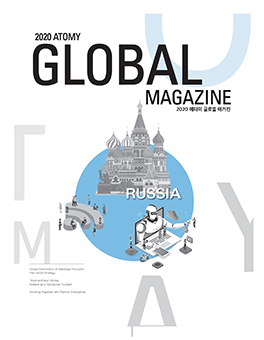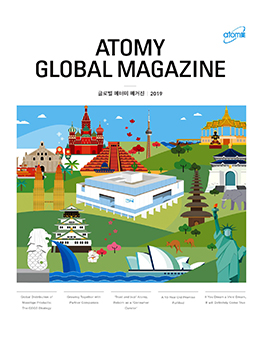글로벌 Global Atomy – Crossing the Indian Ocean to Europe
Global Atomy – Crossing the Indian Ocean to Europe
글로벌 애터미, 인도양을 거쳐 유럽으로
Plans to Start Sales in India and Turkey in 2020
2020년 인도와 터키에서 영업 시작할 계획

Atomy’s footsteps are headed towards the West after having circled the Pacific. In 2020, Atomy plans to launch in the second most populated country in the world and a rising market, India, and Turkey – the western end of Asia and the starting point of Europe. In preparation for the big events, Atomy Magazine will review the markets of India and Turkey.
글로벌 애터미의 발길이 태평양을 돌고 이제 인도양을 거쳐 서쪽으로 향하고 있다. 2020년 애터미는 세계 2위의 인구 대국이자 떠오르는 소비시장으로 주목받고 있는 인도와 아시아의 서쪽 끝이자 유럽이 시작되는 터키에 진출할 계획이다. 이에 애터미 매거진에서는 인도 와 터키 시장을 미리 살펴봤다.
India - A land of opportunity with a population of 1.3 billion and a growing middle class
India is the second biggest country in terms of population with 1.37 billion and by 2030, it is estimated that it will reach 1.48 billion people, placing it at the most populous country in the world. According to India Brand Equity Foundation (IBEF) India’s market size amounts to 672 billion US dollars as of 2017. The critical consumers between the ages of 15 to 59 are predicted to greatly i ncrease i n number by 2030 and Indian market w ill expand t o 4 t rillion U S dollars b y 2025. T he market for Direct Sales is also deemed to advance accordingly and data provided by the World Federation of Direct Selling Associations (WFDSA) reports the India Direct Sales market size as 1.513 billion US dollars, with 7% growth in 2017, putting it at 19th place in the world. The number of salespeople was only 5.1 million, which is a mere 0.3% of the total population and female salespeople only took up 53%. The figure shows that there is much room to grow. The main products sold were from the categories of wellness, cosmetics, and personal care and the trend shows that home appliances and durable goods sales are also gradually increasing. Health food industry is still untapped and is predicted to grow big in the near future. According to Korea Trade-Investment Promotion Agency (KOTRA), the health food market in India is projected to reach 170 billion rupees (2.7 trillion won) within the next five years. As the importance of prevention is becoming more widespread amongst the public, the Ayurvedic products – traditional Indian medicine and remedies – seem to become more popular amongst Indian consumers. Ayurveda is a system of medicine that uses herbs as main ingredients, which is similar to oriental medicine. This i s why there i s a g reat p otential for Atomy’s HemoHim.
India is responsible for 2.71% of the world’s total cosmetics market. In 2017, its domestic market raised 12.63 billion US dollars and Euro Monitor projects the market to have an annual growth rate of 3% and grow up to 14.49 billion US dollars by 2021. Recently, organic and eco-friendly products are becoming more popular amongst consumers, and many are showing more interest towards how traditional Ayurveda products are made. Interest for Korean products are steadily on the rise, even though Hanryu (Korean wave) is still quite unknown. This is because word is spreading between consumers that Korean products have various product lines and good quality. Good results can be expected with Atomy’s products, as the Hanryu is only getting bigger and Atomy can gain leverage due to its product quality and competitive prices. Also, India’s fast-moving consumer goods (FMCG) exceeded 49 billion US dollars in 2016 and is expected to reach up to 103.7 billion US dollars by 2020. Increase in income and improvement of living standards are boosting purchases of products in all price range as well as luxury goods. Along with that, appliances, personal care products (50%), and food products (19%) taking up a big portion of those purchases will work to Atomy’s advantage. As of 2015, the average age in India is 26.9 years and thus, a rapid growth in online and mobile markets is to be expected. Google India predicts that 40% of the India’s FMCG consumption will happen through online platforms by 2020. The future of India’s market is also promising due to the rise of the middle class. According to India’s Economic Institute, by year 2025, India will have a middle class of 547 million people, which also means a very promising future for the Direct Sales. Although India ranked only number 19 with the market size of 2 trillion KRW in 2017, it has the potential to come close to China’ s market. There is now no reason to doubt its possibility for growth, and now is the time to advance into India.
India is responsible for 2.71% of the world’s total cosmetics market. In 2017, its domestic market raised 12.63 billion US dollars and Euro Monitor projects the market to have an annual growth rate of 3% and grow up to 14.49 billion US dollars by 2021. Recently, organic and eco-friendly products are becoming more popular amongst consumers, and many are showing more interest towards how traditional Ayurveda products are made. Interest for Korean products are steadily on the rise, even though Hanryu (Korean wave) is still quite unknown. This is because word is spreading between consumers that Korean products have various product lines and good quality. Good results can be expected with Atomy’s products, as the Hanryu is only getting bigger and Atomy can gain leverage due to its product quality and competitive prices. Also, India’s fast-moving consumer goods (FMCG) exceeded 49 billion US dollars in 2016 and is expected to reach up to 103.7 billion US dollars by 2020. Increase in income and improvement of living standards are boosting purchases of products in all price range as well as luxury goods. Along with that, appliances, personal care products (50%), and food products (19%) taking up a big portion of those purchases will work to Atomy’s advantage. As of 2015, the average age in India is 26.9 years and thus, a rapid growth in online and mobile markets is to be expected. Google India predicts that 40% of the India’s FMCG consumption will happen through online platforms by 2020. The future of India’s market is also promising due to the rise of the middle class. According to India’s Economic Institute, by year 2025, India will have a middle class of 547 million people, which also means a very promising future for the Direct Sales. Although India ranked only number 19 with the market size of 2 trillion KRW in 2017, it has the potential to come close to China’ s market. There is now no reason to doubt its possibility for growth, and now is the time to advance into India.
"India Direct Sales market size as 1.513 billion US dollars, with 7% growth in 2017, putting it at 19th place in the world. The number of salespeople was only 5.1 million, which is a mere 0.3% of the total population and female salespeople only took up 53%. The figure shows that there is much room to grow."
인도 - 13억의 인구와 확대되는 중산층으로 떠오르는 기회의 땅
인도는 약 13억 7000만 명의 인구를 가진 세계 2위의 인구 대국으로 오는 2030년 14억 8000만 명을 넘어 세계 1위의 인구 대국으로 성장할 것으로 예측된다. IBEF(IndiaBrand Equity Foundation)에 따르면, 2017년 기준 인도소비시장 규모는 6720억 달러이다. 소비를 주도할 15~59세 인구수가 2030년까지 크게 늘어날 것으로 보여 2025년인도의 소비시장은 4조 달러에 이를 것으로 전망된다.
직접판매 시장도 성장세가 가파르다. WFDSA 자료에 따르면 세계 19위에 해당하는 인도의 직접판매 시장은 지난2017년 기준 15억 1300만 달러(약 1조 7000억 원) 규모로 2016년 대비 7.0% 성장했다. 판매원수는 510만여 명으로 총인구의 0.3% 밖에 되지 않으며 여성의 비율이 53.0%에 불과해 앞으로 성장의 여지가 매우 크다. 주력 제품군은웰니스와 화장품 및 퍼스널케어이며 가정용품 및 내구재의비중도 점착 확대되고 있는 추세다.
인도의 건강식품 시장은 아직 미개척 분야이면서 빠른 시일 내에 크게 성장할 수 있는 대표적인 시장으로 평가되고있다. KOTRA 자료에 따르면 향후 5년 내 1700억 루피(2조 7000억 원) 규모로 성장할 것으로 기대된다. 또한 병에걸리기 전에 '예방'하는 것이 최선이라는 인식이 점차 확산되고 있으며 특히 인도에서 전통적으로 전해 내려오는 아유르베딕 제품에 대한 선호도가 높다. 아유르베다는 허브(Herb)를 기반으로 한다는 점에서 한방의학과 유사한 면이있다. 애터미의 헤모힘이 기대되는 이유다.
인도의 화장품 시장은 2017년 기준 126억 3400만 달러 규모로 세계 시장의 2.71%를 차지하고 있다. 유로모니터에 따르면 2021년까지 약 144억 9000만 달러(약 16조 5000억원)까지 증가해 매년 3% 수준의 안정적 성장세를 기록할전망이다. 최근에는 유기농, 친환경 제품에 대한 소비자 선호가 확대되고 인도 고유의 아유르베다 제조기법에 대한관심이 높아지고 있다는 점이 특징으로 꼽힌다. 한국산 제품에 대한 관심은 꾸준히 이어지고 있으며 아직 미약한 한류에도 불구하고 다양한 라인업과 좋은 품질로 입소문을 타고 있다. 커져가는 한류 붐에 애터미의 품질과 가격경쟁력이 더해진다면 좋은 결과를 기대할 수 있다.
또 인도 생활소비재시장은 2016년 기준 490억 달러를 돌파한 이후 2020년까지 1037억 달러까지 성장할 것으로 전망된다. 소득증가 및 생활여건 개선으로 저가부터 고가 프리미엄 제품군까지 소비 확대되고 있으며 가정용품, 퍼스널케어 제품군(50%)과 식음료 제품군(19%)의 비중이 높다는 점도 애터미에게는 유리한 측면이다. 특히 인도의 평균연령은2015년 기준 26.9세에 불과해 온라인 및 모바일 시장의 급성장이 예상된다. Google India에 따르면 2020년까지 인도생활소비재(FMCG) 소비의 40%는 온라인을 통해 이뤄질전망이다.
인도의 소비 시장은 중산층이 큰 폭으로 확대되고 있어 미래가 더욱 기대되는 시장이다. 인도 국가경제연구원에 따르면 오는 2025년 인도의 중산층 인구는 5억 4700만 명에 달할 전망이다. 직접판매 시장 역시 성장잠재력이 풍부하다.비록 2017년 기준으로는 2조 원에 못 미치는 세계 19위 수준이지만 향후 중국에 버금갈 수 있는 잠재력을 가지고 있다고 할 수 있다. 인도의 성장은 이제 의심할 여지가 없으며 지금이 진출 적기인 셈이다
직접판매 시장도 성장세가 가파르다. WFDSA 자료에 따르면 세계 19위에 해당하는 인도의 직접판매 시장은 지난2017년 기준 15억 1300만 달러(약 1조 7000억 원) 규모로 2016년 대비 7.0% 성장했다. 판매원수는 510만여 명으로 총인구의 0.3% 밖에 되지 않으며 여성의 비율이 53.0%에 불과해 앞으로 성장의 여지가 매우 크다. 주력 제품군은웰니스와 화장품 및 퍼스널케어이며 가정용품 및 내구재의비중도 점착 확대되고 있는 추세다.
인도의 건강식품 시장은 아직 미개척 분야이면서 빠른 시일 내에 크게 성장할 수 있는 대표적인 시장으로 평가되고있다. KOTRA 자료에 따르면 향후 5년 내 1700억 루피(2조 7000억 원) 규모로 성장할 것으로 기대된다. 또한 병에걸리기 전에 '예방'하는 것이 최선이라는 인식이 점차 확산되고 있으며 특히 인도에서 전통적으로 전해 내려오는 아유르베딕 제품에 대한 선호도가 높다. 아유르베다는 허브(Herb)를 기반으로 한다는 점에서 한방의학과 유사한 면이있다. 애터미의 헤모힘이 기대되는 이유다.
인도의 화장품 시장은 2017년 기준 126억 3400만 달러 규모로 세계 시장의 2.71%를 차지하고 있다. 유로모니터에 따르면 2021년까지 약 144억 9000만 달러(약 16조 5000억원)까지 증가해 매년 3% 수준의 안정적 성장세를 기록할전망이다. 최근에는 유기농, 친환경 제품에 대한 소비자 선호가 확대되고 인도 고유의 아유르베다 제조기법에 대한관심이 높아지고 있다는 점이 특징으로 꼽힌다. 한국산 제품에 대한 관심은 꾸준히 이어지고 있으며 아직 미약한 한류에도 불구하고 다양한 라인업과 좋은 품질로 입소문을 타고 있다. 커져가는 한류 붐에 애터미의 품질과 가격경쟁력이 더해진다면 좋은 결과를 기대할 수 있다.
또 인도 생활소비재시장은 2016년 기준 490억 달러를 돌파한 이후 2020년까지 1037억 달러까지 성장할 것으로 전망된다. 소득증가 및 생활여건 개선으로 저가부터 고가 프리미엄 제품군까지 소비 확대되고 있으며 가정용품, 퍼스널케어 제품군(50%)과 식음료 제품군(19%)의 비중이 높다는 점도 애터미에게는 유리한 측면이다. 특히 인도의 평균연령은2015년 기준 26.9세에 불과해 온라인 및 모바일 시장의 급성장이 예상된다. Google India에 따르면 2020년까지 인도생활소비재(FMCG) 소비의 40%는 온라인을 통해 이뤄질전망이다.
인도의 소비 시장은 중산층이 큰 폭으로 확대되고 있어 미래가 더욱 기대되는 시장이다. 인도 국가경제연구원에 따르면 오는 2025년 인도의 중산층 인구는 5억 4700만 명에 달할 전망이다. 직접판매 시장 역시 성장잠재력이 풍부하다.비록 2017년 기준으로는 2조 원에 못 미치는 세계 19위 수준이지만 향후 중국에 버금갈 수 있는 잠재력을 가지고 있다고 할 수 있다. 인도의 성장은 이제 의심할 여지가 없으며 지금이 진출 적기인 셈이다
"인도의 직접판매 시장은 지난 2017년 기준 15억 1300만 달러(약 1조 7000억 원) 규모로 2016년 대비 7.0% 성장했다. 판매원수는 510만여 명으로 총인구의 0.3% 밖에 되지 않으며 여성의 비율이 53.0%에 불과해 앞으로 성장의 여지가 매우 크다."
Turkey - The gateway connecting Asia and Europe
Turkey has a long history with South Korea. The ancestors of the Turkish, the Huns and the Gokturks, neighbored the Old Chosun Dynasty and during the Korean War, Turkey came to aid as allies, resulting in many casualties. Because of such history, the Turkish people have a positive attitude towards Koreans even today, and they call Koreans Can Kardes, which means “brothers tied by blood” As of 2017, Turkey has a population of 83 million people, and their Gross Domestic Product (GDP) ranks number 17 in the world with 851.1 billion US dollars. It also has an economic growth rate of 7.42%. According to KOTRA’s data, Turkey’s retail market has grown from 43.5 billion US dollars in 2014 to 51.7 billion US dollars in 2017 with its population and a high, young consumer ratio. Due to easier access to the internet and mobile platforms, online shopping markets are rapidly on the rise and the Influencer Marketing from social media platforms is also growing. Turkey’s Direct Sales market has also displayed an outstanding annual growth rate of 11.6% from 2014 until 2017. The fact that the future of the Turkish economy does not look so bright may also mean otherwise for Direct Sales. According to Euro Monitor, many Turkish people are becoming more sensitive to their job security and feel the need for additional income. This is helping the Direct Sales network to expand in Turkey.
In 2017, Turkey’s total sales for Direct Sales amounted to 732 million US dollars, and the number of salespeople were 1.5 million. Though Turkey is an Islamic country with relatively higher economic restrictions for women, 84.2% of all Direct Sales workers are females. Naturally, cosmetic products are responsible for 60.9% of all Direct Sales purchases (2014 data). An interesting statistic is that wellness and health food products took up only 10%, while durable goods and household appliances did better with 18.7% of total sales. Due to the changes in the consumers’ lifestyle caused by urbanization and the increase in women’s economic participation, Turkey’s cosmetics market is growing at an annual rate of 15%. However, due to the plunge in the exchange rate, the market for dollar exchange has decreased by 4% to 3.5 billion dollars. The category for hair care marked the most sales with 700 million US dollars – responsible for 19.7% of total sales for Direct Sales. Trailing behind hair care were skin care (16.6%), color cosmetics (14.3%), and perfumes (11.6%). About 59% of the sales for hair care were shampoo products and shaving and cutting hair products were also popular. The natural cosmetics are also on the rise. And with K-Pop fans at the center of a new trend, K-Beauty is also becoming more popular to the consumers in their 10s and 20s who feel more comfortable with different cultures. According to an expert in the Turkish cosmetics industry, Korean products are known to be costeffective, but they seem to be relatively expensive. Currently, the most popular Korean cosmetic products are BB cream, mask packs, and cushion compacts.
The market for health food products were worth 152 million US dollars in 2015 but is projected to grow to 255 million US dollars by 2020. Research shows that Turkish consumers mostly looked for health food products for immune system improvement and fatigue prevention. Students and office workers, on the other hand, looked for products to enhance concentration and most sold products were Vitamin C, Vitamin B, and Calcium. Meanwhile, Journal of Business Research in Turkey published an opinion that oriental medicine products with scientifically proven effects could be beneficial for the Turkish people’s health.
Geographically, Turkey is located in the far west tip of Asia while acting as a gateway into Europe. About 20% of Turkish land is within European boarders and Turkey is currently pursuing an European Union membership. Launching in Turkey is much more significant than just going into another foreign market. It can serve as an outpost as Atomy expands to the Middle East and Europe in the near future.
The market for health food products were worth 152 million US dollars in 2015 but is projected to grow to 255 million US dollars by 2020. Research shows that Turkish consumers mostly looked for health food products for immune system improvement and fatigue prevention. Students and office workers, on the other hand, looked for products to enhance concentration and most sold products were Vitamin C, Vitamin B, and Calcium. Meanwhile, Journal of Business Research in Turkey published an opinion that oriental medicine products with scientifically proven effects could be beneficial for the Turkish people’s health.
Geographically, Turkey is located in the far west tip of Asia while acting as a gateway into Europe. About 20% of Turkish land is within European boarders and Turkey is currently pursuing an European Union membership. Launching in Turkey is much more significant than just going into another foreign market. It can serve as an outpost as Atomy expands to the Middle East and Europe in the near future.
"Turkey’s Direct Sales market has also displayed an outstanding annual growth rate of 11.6% from 2014 until 2017. The fact that the future of the Turkish economy does not look so bright may also mean otherwise for Direct Sales."
터키 - 아시아와 유럽을 잇는 관문
터키는 한국과 인연이 깊다. 터키인의 조상은 흉노와 돌궐로 고조선 시대부터 이웃에 살던 민족이며 6·25 전쟁 때에는 연합군으로 참전, 많은 터키 군인들이 목숨을 잃거나 다쳤다. 이런 배경으로 인해 터키인들은 지금도 한국을 매우친하게 생각하여 칸카르데쉬, 즉 피로 맺어진 형제라고 부른다.
8300만여 명의 인구를 가진 터키의 2017년 기준 GDP(국내총생산)는 8511억 달러로 세계 17위에 해당하며 경제성장률은 7.42%에 달한다. KOTRA의 자료에 따르면 8천만 명의 인구와 높은 청년인구 비율을 지닌 터키의 유통시장 규모는 지난 2014년 435억 달러에서 2017년에는 517억 달러로 확대되고 있다. 특히 인터넷 및 모바일 보급 급증에 따라, 온라인 쇼핑 시장이 급성장 중이며, SNS 등을 활용한인플루언서 마케팅 역시 확대 중인 것으로 나타났다.터키의 직접판매 시장은 2014년부터 2017년까지 연평균11.6%의 성장률을 기록하고 있을 정도로 매우 급성장하고있다. 특히 최근 터키의 경제 전망이 좋지 않은 점도 향후터키의 직접판매 시장 전망을 밝게 하는 요인이 되고 있다.유로모니터에 따르면 많은 터키 사람들이 직업에 대해 불안해하며 추가 수입의 필요성을 느끼고 있어 직접판매 네트워크를 확장하는데 도움을 주고 있다.
8300만여 명의 인구를 가진 터키의 2017년 기준 GDP(국내총생산)는 8511억 달러로 세계 17위에 해당하며 경제성장률은 7.42%에 달한다. KOTRA의 자료에 따르면 8천만 명의 인구와 높은 청년인구 비율을 지닌 터키의 유통시장 규모는 지난 2014년 435억 달러에서 2017년에는 517억 달러로 확대되고 있다. 특히 인터넷 및 모바일 보급 급증에 따라, 온라인 쇼핑 시장이 급성장 중이며, SNS 등을 활용한인플루언서 마케팅 역시 확대 중인 것으로 나타났다.터키의 직접판매 시장은 2014년부터 2017년까지 연평균11.6%의 성장률을 기록하고 있을 정도로 매우 급성장하고있다. 특히 최근 터키의 경제 전망이 좋지 않은 점도 향후터키의 직접판매 시장 전망을 밝게 하는 요인이 되고 있다.유로모니터에 따르면 많은 터키 사람들이 직업에 대해 불안해하며 추가 수입의 필요성을 느끼고 있어 직접판매 네트워크를 확장하는데 도움을 주고 있다.
2017년 터키의 직접판매 매출총액은 7억 3200백만 달러(약 8276억 원)이며 판매원 숫자는 150만여 명이다. 여성의경제활동에 대한 제약이 상대적으로 많은 이슬람국가임에도 직접판매원 가운데 여성의 비중이 84.2%에 달하고 있으며 이에 따라 직접판매를 통해 판매되는 제품도 화장품이60.9%를 차지하고 있다(2014년 기준). 특이한 점은 건강식품 등 웰니스 제품군이 차지하는 비중이 10.0%에 불과한반면 가정용품 및 내구재가 차지하는 비중이 18.7%로 높다는 점이다.
터키 화장품 시장은 도시화 및 여성의 경제 활동 증가에 따른 라이프 스타일의 변화로 잠재소비자가 증가함에 따라매년 15% 이상 성장하고 있다. 그러나 환율하락으로 인해 달러 환산 시장규모는 2017년 기준 35억 달러로 전년 대비4% 감소한 것으로 나타났다. 가장 매출 규모가 큰 품목인헤어케어 부문은 약 7억 달러 규모로 전체 시장의 19.7%를 차지하고 있으며 뒤이어 스킨케어(16.6%), 색조화장품(14.3%), 향수류(11.6%) 순이다. 헤어케어 부문의 59%는 샴푸가 차지하고 있으며 면도제품, 제모기 등도 활발히 판매되고 있다. 특히 최근 들어서는 천연화장품 시장이 활기를띄고 있다. 또한 K-Pop 팬을 주축으로 다양한 문화에 대해 거부감이 낮고 적극적으로 수용하는 10대, 20대 소비층을 중심으로 K-Beauty에 대한 인기가 높아지고 있다. 터키 화장품 업계 관계자에 따르면 한국산 제품은 가성비는좋으나 인지도에 비해 비싸며 인기를 얻고 있는 제품은 BB크림, 마스크팩, 쿠션컴팩트 등이다.
건강식품 시장 규모는 지난 2015년 1억 5200만 달러(약1721억 원)였으며 오는 2020년까지 2억 5500만 유로(2574억원)으로 확대될 전망이다. 터키인들은 주로 면역과 피로예방을 위해 건강식품을 찾고 있으며 학생이나 사무직 근로자들은 집중력 강화를 위한 제품을 많이 찾는 것으로 나타났다. 가장 많이 판매되는 제품은 비타민 C와 B, 그리고 칼슘인 것으로 조사 됐다. 한편 터키의 비즈니스 잡지(Journal of Business Research)는 과학적으로 입증된 한방 건강식품 브랜드가 터키 국민의 건강에 기여할 수 있다는 의견을 밝히기도 했다.
지정학적으로 터키는 아시아의 서쪽 끝이자 유럽과 연결되는 국가이다. 영토의 20%가 유럽에 속해 있으며 현재 EU가입을 위해 상당한 노력을 하고 있다. 따라서 애터미의 터키 진출은 단순히 새로운 시장의 개척을 넘어 향후 중동및 유럽 진출의 전초기지가 된다는 점에서도 그 의미가 작지 않다.
터키 화장품 시장은 도시화 및 여성의 경제 활동 증가에 따른 라이프 스타일의 변화로 잠재소비자가 증가함에 따라매년 15% 이상 성장하고 있다. 그러나 환율하락으로 인해 달러 환산 시장규모는 2017년 기준 35억 달러로 전년 대비4% 감소한 것으로 나타났다. 가장 매출 규모가 큰 품목인헤어케어 부문은 약 7억 달러 규모로 전체 시장의 19.7%를 차지하고 있으며 뒤이어 스킨케어(16.6%), 색조화장품(14.3%), 향수류(11.6%) 순이다. 헤어케어 부문의 59%는 샴푸가 차지하고 있으며 면도제품, 제모기 등도 활발히 판매되고 있다. 특히 최근 들어서는 천연화장품 시장이 활기를띄고 있다. 또한 K-Pop 팬을 주축으로 다양한 문화에 대해 거부감이 낮고 적극적으로 수용하는 10대, 20대 소비층을 중심으로 K-Beauty에 대한 인기가 높아지고 있다. 터키 화장품 업계 관계자에 따르면 한국산 제품은 가성비는좋으나 인지도에 비해 비싸며 인기를 얻고 있는 제품은 BB크림, 마스크팩, 쿠션컴팩트 등이다.
건강식품 시장 규모는 지난 2015년 1억 5200만 달러(약1721억 원)였으며 오는 2020년까지 2억 5500만 유로(2574억원)으로 확대될 전망이다. 터키인들은 주로 면역과 피로예방을 위해 건강식품을 찾고 있으며 학생이나 사무직 근로자들은 집중력 강화를 위한 제품을 많이 찾는 것으로 나타났다. 가장 많이 판매되는 제품은 비타민 C와 B, 그리고 칼슘인 것으로 조사 됐다. 한편 터키의 비즈니스 잡지(Journal of Business Research)는 과학적으로 입증된 한방 건강식품 브랜드가 터키 국민의 건강에 기여할 수 있다는 의견을 밝히기도 했다.
지정학적으로 터키는 아시아의 서쪽 끝이자 유럽과 연결되는 국가이다. 영토의 20%가 유럽에 속해 있으며 현재 EU가입을 위해 상당한 노력을 하고 있다. 따라서 애터미의 터키 진출은 단순히 새로운 시장의 개척을 넘어 향후 중동및 유럽 진출의 전초기지가 된다는 점에서도 그 의미가 작지 않다.
"터키의 직접판매 시장은 2014년부터 2017년까지 연평균 11.6%의 성장률을 기록하고 있을 정도로 매우 급성장하고 있다.
특히 최근 터키의 경제 전망이 좋지 않은 점도 향후 터키의 직접판매 시장 전망을 밝게 하는 요인이 되고 있다."





